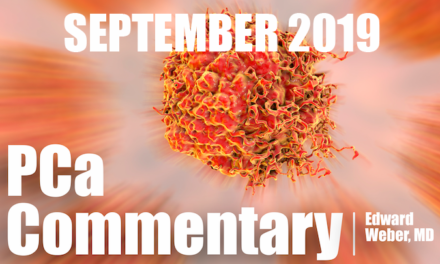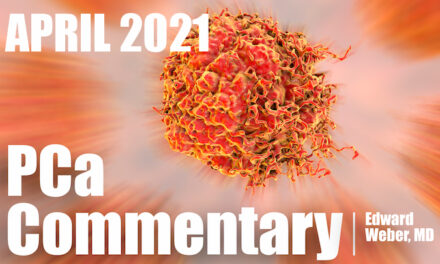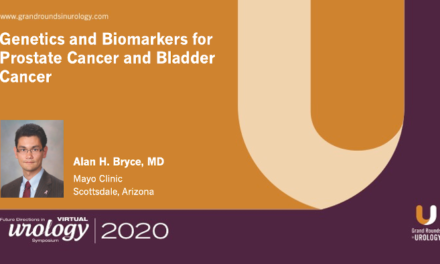
PCa Commentary | Volume 177 – May 2023
Posted by Edward Weber | May 2023
DECIPHER: Predicting Prognosis and Assisting Treatment Decisions
Decipher assays the RNA expression of 22 genes, and estimates the rate of distant metastases at 5 years and prostate cancer-specific mortality at 10 years, thus providing risk-stratification to assist in treatment decisions. Three examples:
- providing guidance for men newly-diagnosed with prostate cancer considering active surveillance (AS);
- indicating the extent of benefit from the addition of ADT to radiation therapy at post-prostatectomy recurrence; and,
- predicting the benefit of adding ADT to primary radiation for men with intermediate-risk cancer.
The Decipher score is based on the unique molecular make-up of each man’s cancer and performs better in assessing prognosis than conventional tools, i.e., Gleason score, NCCN risk groups, and clinical characteristics. It is assessed on surgical specimens or biopsy tissue, is commercially available, Medicare covered, and updated as new data is collected.
Decipher—Patient Selection for Active Surveillance.
The key to appropriate patient selection for active surveillance is an accurate prognosis, which can inform the decision if intervention can safely be delayed. Men diagnosed with low-risk cancer, i.e., Gleason 3+3, PSA < 10 ng/ml, and localized disease are generally considered appropriate for AS without further evaluation. Favorable Intermediate-risk cancer (i.e., Gleason Score 3+4, PSA < 20 ng/mL and more extensive disease within the prostate) is a heterogeneous category where Decipher can be helpful in deciding suitability for AS. Decipher risk thresholds are 0-0.45 (low risk); 0.45-0.6 (avg. risk) and 0.6-1.0 (high-risk). The Decipher report assigns an individual’s risk between 0 and 1.0.
Kim et al., addressed this issue in “Validation of the Decipher Test for predicting adverse pathology in candidates for prostate cancer active surveillance,” (Prostate Cancer and Prostatic Disease, 2019). The study assessed 266 men with low- (65%) or favorable intermediate-risk (35%) cancer with Decipher prior to prostatectomy. The Decipher was trained on prostatectomy specimens to predict adverse pathology in the surgical specimen—i.e. Gleason score 4+3 or higher, advanced local stage, or lymph node involvement. These features customarily disqualify men from AS.
Findings:
“A Decipher score < 0.2 would provide a strong case for patients considering AS,” since only 5% would be predicted to have adverse pathology (AP). Those men with Decipher scores between 0.2 and 0.45 have 91% likelihood of being free of adverse pathology and also are suitable candidates for AS.
“A practical way to apply these cutoffs is to strongly recommend AS for scores < 0.2 since the risk of AP is only 5% and recommend definite local therapy for scores > 0.45 where the risk of AP is 19%,” (ibid, Kim).
Dr. Feng, Professor of Radiation Oncology, Urology and Medicine, Univ. of CA, San Francisco, commented: “My approach is to recommend active surveillance for most of my low-risk patients, but if my patients are uncomfortable with that approach, I will order genomic classification. If the genomic risk score is high, I am more likely to lean toward recommending surgery or radiation.” (Quote from Prostate Cancer in Focus).
Decipher—Post-Prostatectomy Radiation at PSA Recurrence: Is Adjuvant Androgen Deprivation Therapy (ADT) of Much or Little Benefit?
Men with rising PSAs following radical prostatectomy are customarily treated with a course of radiation therapy—immediately upon recovery (“adjuvant”) or delayed (“salvage,” usually commenced before the PSA rises above 0.5 ng/mL). Radiation is customarily accompanied by a variable period of ADT, which confers a survival benefit, but is associated with the well-recognized adverse effects of testosterone suppression.
Do all men receiving radiation at recurrence benefit equally from the addition of ADT? This was addressed by Feng et al., “Validation of a 22-Gene Genomic Classifier [Decipher] in Patients with Recurrent Prostate Cancer,” (JAMA Oncology, 2021). The study reported the outcome of a 352- man clinical trial of salvage radiation plus 2 years of 150mg of the anti-androgen Casodex compared with no hormone therapy. The low-, intermediate-, and high-risk groups comprised 42%, 38% and 20% of men. Radiation was started at PSA values between 0.2-4.0 ng/mL.
This study retrospectively tested the men’s surgical specimens with Decipher and linked the Decipher scores to clinical outcomes—overall survival, distant metastases, and cancer-specific survival. All men receiving Casodex benefited, but among those receiving the anti-androgen, Decipher detected a difference in extent of benefit comparing the men with low (scores 0-0.45) to a combined intermediate- and high-risk group, >0.45-1.0.
Findings:
- The overall survival at 12 years for the low-score group was only 2.4% better for those receiving Casodex as opposed to no hormone treatment. However, overall survival for the men in the combined intermediate/high-risk group receiving Casodex, the gain was 8.9% in the overall survival compared to no hormone suppression. For distant metastases in the low-risk group (<0.45) Casodex provided only a 5% gain vs placebo compared to a gain of 15.7% in group with scores > 0.45. In brief, men with low Decipher risk scores benefit relatively little from androgen suppression, and this raises the issue of whether that small gain outweighs the toxicity of ADT. [In the USA the hormone suppression would generally be done with Lupron or a similar agent.]
- When early salvage radiation was commenced at PSA < 0.7 ng/mL, those with low Decipher scores of <0.45 gained even less from adding hormone suppression in the development of distant metastases 4.6% vs 11.2% for the higher score group.
This information can be the basis of a discussion of the benefit vs harms of adding hormone suppression therapy to radiation at recurrence after prostatectomy.
Decipher—With Primary Radiation for Intermediate-risk Cancer: Do All Men Require ADT?
Background:
It has become standard practice to offer a 4-6 month course of ADT in association with primary radiation for unfavorable intermediate-risk (UIR) prostate cancer, as defined by NCCN—and withholding it for favorable risk (FIR) disease. This practice is based on the study by Zumsted et al., (JAMA Network, 2020). The benefit of adding ADT in FIR was insignificant, but by adding ADT in UIR the 15-year rate of distant metastases (DM) was significantly improved—10% (ADT) vs 24% (no ADT).
Open Question: Would the benefits and harms of ADT be better distributed if prescribed on the basis of Decipher scores as opposed to the NCCN favorable/unfavorable stratification?
A study presented at ASCO 2022 offered guidance as to which men with intermediate-risk prostate cancer were sufficiently treated with radiation without ADT and, by implication, who might benefit with supplemental androgen suppression. The work was reported by Dr. Dan Spratt, Professor and Chair of the Department of Radiation Oncology at Case Western Reserve School of Medicine, “Validation of the performance of Decipher biopsy genomic classifier in intermediate-risk prostate cancer.” At 10 years, 5% of men with low Decipher scores experienced distant metastases compared to 26% with high Decipher scores, suggesting that ADT might be appropriate in the Decipher high-risk group.
The Future: … and the possibility of a new standard of care.
A clarification of the comparative gains achievable in FIR and UIR with the addition of ADT will likely result from the ongoing NCT clinical trial NCT05050084 “GUIDANCE,” wherein men with intermediate-risk cancer with low Decipher scores will be randomized between radiation therapy plus 6-month ADT or no ADT. Men with high Decipher scores will receive radiation and be randomized between ADT alone or combined with darolutamide.
BOTTOM LINE:
Decipher, a genomic risk-stratifier that estimates prognosis on the basis of the unique molecular characteristics of a man’s prostate cancer, can offer guidance in treatment decisions.
Please also visit https://prostatecancerfree.org/prostate-cancer-news for a selection of past issues of the PCa Commentary covering a variety of topics.
“I want to thank Dawn Scott, Staffperson, Tumor Institute Radiation Oncology Group, and Mike Scully, Librarian, Swedish Medical Center, for their unfailing, timely, and resourceful support of the Commentary project. Without their help this Commentary would not be possible.”
ABOUT THE AUTHOR
Edward Weber, MD, is a retired medical oncologist living in Seattle, Washington. He was born and raised in a suburb of Reading, Pennsylvania. After graduating from Princeton University in 1956 with a BA in History, Dr. Weber attended medical school at the University of Pennsylvania. His internship training took place at the University of Vermont in Burlington.
A tour of service as a Naval Flight Surgeon positioned him on Whidbey Island, Washington, and this introduction to the Pacific Northwest ultimately proved irresistible. Following naval service, he received postgraduate training in internal medicine in Philadelphia at the Pennsylvania Hospital and then pursued a fellowship in hematology and oncology at the University of Washington.
His career in medical oncology was at the Tumor Institute of the Swedish Hospital in Seattle where his practice focused largely on the treatment of patients experiencing lung, breast, colon, and genitourinary cancer and malignant lymphoma.
Toward the end of his career, he developed a particular concentration on the treatment of prostate cancer. Since retirement in 2002, he has authored the PCa Commentary, published by the Prostate Cancer Treatment Research Foundation, an analysis of new developments in the prostate cancer field with essays discussing and evaluating treatment management options in this disease. He is a regular speaker at various prostate cancer support groups around Seattle.




